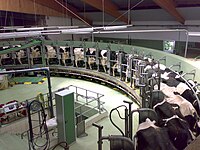
Photo from wikipedia
The study applied a targeted quantitative metabolomics approach using a combination of direct injection and tandem mass spectrometry (DI-MS/MS) with a liquid chromatography-tandem mass spectrometry (LC-MS/MS)-based plasma metabolomics to evaluate… Click to show full abstract
The study applied a targeted quantitative metabolomics approach using a combination of direct injection and tandem mass spectrometry (DI-MS/MS) with a liquid chromatography-tandem mass spectrometry (LC-MS/MS)-based plasma metabolomics to evaluate the effects of supplementing clay and/or a Saccharomyces cerevisiae fermentation product (SCFP) on the metabolic status of dairy cows challenged with aflatoxin B1. Eight lactating cows were randomly assigned to 1 of 4 treatments in a balanced 4 × 4 Latin square design with 2 squares. Treatments were control, toxin (T; 1725 µg AFB1/head/day), T with clay (CL; 200 g/head/day), and CL with SCFP (CL+SCFP; 35 g of SCFP/head/day). Cows in T, CL, and CL+SCFP were dosed with aflatoxin B1 (AFB1) from d 26 to 30. The sequestering agents were top-dressed from d 1 to 33. On d 30 of each period, 15 mL of blood was taken from the coccygeal vessels and plasma samples were prepared by centrifugation. Plasma samples were analyzed using a kit that combines DI-MS/MS with LC-MS/MS. The data were analyzed using the GLIMMIX procedure of SAS. The model included the effects of treatment, period, and random effects of cow and square. Significance was declared at P ≤ 0.05. A total of 128 metabolites, including amino acids, biogenic amines, acylcarnitines, glycerophospholipids, and organic acids were quantified. Compared to the control, T decreased (P ≤ 0.05) plasma concentrations of 16 metabolites (6 amino acids, 6 acylcarnitines, and 4 glycerophospholipids). In contrast, T increased plasma concentrations of sarcosine, uric acid, and aspartic acid. Treatment with CL increased concentrations of arginine, lysine, and 5 organic acids. Treatment with CL+SCFP increased the concentrations of 7 amino acids and 4 acylcarnitines, but reduced the concentrations of sarcosine and 3 organic acids. Results of this study indicate that supplementing clay and/or SCFP altered plasma metabolomic profile in dairy cows challenged with AFB1.
Journal Title: Journal of Animal Science
Year Published: 2019
Link to full text (if available)
Share on Social Media: Sign Up to like & get
recommendations!